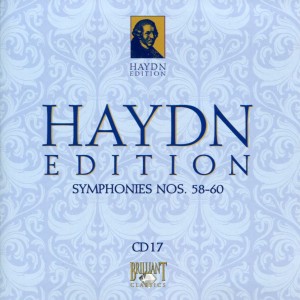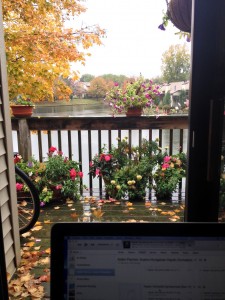 What a long, strange day this has been.
What a long, strange day this has been.
I arose late this morning because I was up again during the night. (Acid reflux is not my friend, although it is an occasional acquaintance.)
Therefore, I didn’t get to Panera at my usual time, and so didn’t get my usual table. The place was packed.
My butt could find no purchase.
So I drove around wondering where to go, visions of Light Roast coffee dancing in my head. Finally, around 8:30am, I decided to return to Panera and hope for the best.
I was in luck — or, so I thought. There were booths open, and Light Roast coffee aplenty, but when I opened up my laptop and sought Haydn CD 17 in iTunes, I couldn’t find it.
Son of a gun, I thought (only with less finesse). I can’t believe this.
Thwarted, I worked on grading student papers, offering design suggestions for a new logo project, posting on Facebook, and, around noon, decided to leave to work from home.
 I set up a table by the balcony and popped Haydn CD 17 into my computer, only to discover that iTunes says it was there all along. Huh? Where?
I set up a table by the balcony and popped Haydn CD 17 into my computer, only to discover that iTunes says it was there all along. Huh? Where?
Wonderful. Now I have to play Haydn seek to find the music that apparently isn’t lost after all.
I finally located it. For some reason when iTunes ripped that particular CD it chose a different name to put it under, so it wasn’t with its brethren in the Adam Fischer category.
“Son of a gun,” I said aloud. “You mean to tell me I could have listened to Haydn earlier this morning and didn’t have to come back here after all?”
I got no answer, probably because the walls assumed my query was rhetorical — which, I suppose, it was. But the least they could have done is grunted some sort of reply, if for no other reason than to acknowledge I asked a question.
Great, I thought. Even the walls are against me today.
Of course, if the walls had replied with anything — grunt or not — I’m certain a heart attack would have followed in close proximity. When do walls ever talk?
After a big bowl of homemade chicken noodle soup, I pushed Play on Hadyn CD 17 and was captivated from Movement I (“Allegro”) of Symphony No. 58 in F, which was composed in 1774 when Haydn was 42. I found this symphony to be bright, lively, and enjoyable.
Symphony No. 59 in A “Feuersymphonie” followed, and this time, surprisingly, I enjoyed the slower Movement II (“Andante o piu tosto allegretto”) as much as the faster Movement I (“Presto”). In fact, this “Fire Symphony,” as it is nicknamed, is terrific from start to finish. Easily one of my favorites to date.
Apparently, this symphony is out of place, chronologically. According to its entry on Wiki:
Despite its high number, the symphony is one of several in the Hoboken classification system (Symphony No. 72 is another good example as it was composed even earlier) that is egregiously out of place. It is, in fact, a quite early work, certainly composed before 1769, and possibly a fair bit earlier.
Okay. So if this was composed in 1769, that means Haydn was 37. I’d hardly call that “egregiously out of place.” What’s 4-5 years out of sequence?
What I find more interesting is its nickname. According to Wiki:
The symphony has long been popularly known as the Feuer or Fire symphony. As with most other monikers attached to Haydn’s symphonies, the name itself did not originate with the composer. For a long time, the attributed title was thought to refer to the fiery nature of the composition, particularly the rather unusually spirited first movement (marked Presto, a tempo indication more typical of final movements) and the brief but energetic last movement, which features prominent horn fanfares and corruscating runs on the strings. However, there is nothing particularly distinguishing about any of the movements that would make it more impassioned than other symphonic compositions by Haydn during this period.
Instead, the nickname almost certainly derives from the use of several movements as accompanying music to a performance of the play Der Feuersbrunst by Gustav Friedrich Wilhelm Großmann, which was performed at Eszterháza in either (depending on the source) 1774 or 1778. An extant manuscript of the symphony dating from Haydn’s lifetime bears the title Feueur Sinfonia. Earlier claims that the symphony originated first as theatrical music (like the Symphony No. 60 Il Distratto) are inaccurate.
Symphony No. 60 in C “Il Distratto” features five movements and, according to one conductor, is one of Haydn’s finest:
The conductor Kenneth Woods describes it as “the funniest and most modern work on [my] list, possibly the funniest and most modern symphony ever written. Haydn uses most of the 20th c ‘isms’ in this piece- surrealism, absurdism, modernism, poly-stylism, and hops effortlessly between tightly integrated symphonic argument and rapid-fire cinematic jump-cutting. This is Haydn at his absolute boldest- he undermines every expectation, and re-examines every possible assumption about music.
The nickname derives from the:
…music Haydn wrote for a play, Le Distrait, by Jean-François Regnard, given a German revival in 1774 by Karl Wahr under the German title »Der Zerstreute« (Il Distratto is the title that appears on Haydn’s incidental music, however). Symphony no. 60 contains the overture, four entr’actes and finale from the music composed for the five-act play.
I liked Il Distratto. But I preferred Symphony No. 59 (“Fire Symphony”).
Symphony No. 60 was written in 1775 when Haydn was 43.

I’ve never thought of a symphony as being funny before. I didn’t realize Haydn was a comedian!
Well, maybe a symphony isn’t particulary funny, but Bill can make it seem so. Fascinating, the writing of a symphony and the writing about it, or writing to it. Would the creators of these things Bill is going to be relating to and commenting on ever imagine their works to be background activity? Doubtful. And yet, there they are. And wonderful the world for all of it is…the then and the now. Combined for our pleasure.
I am he as you are he as you are me and we are all together.